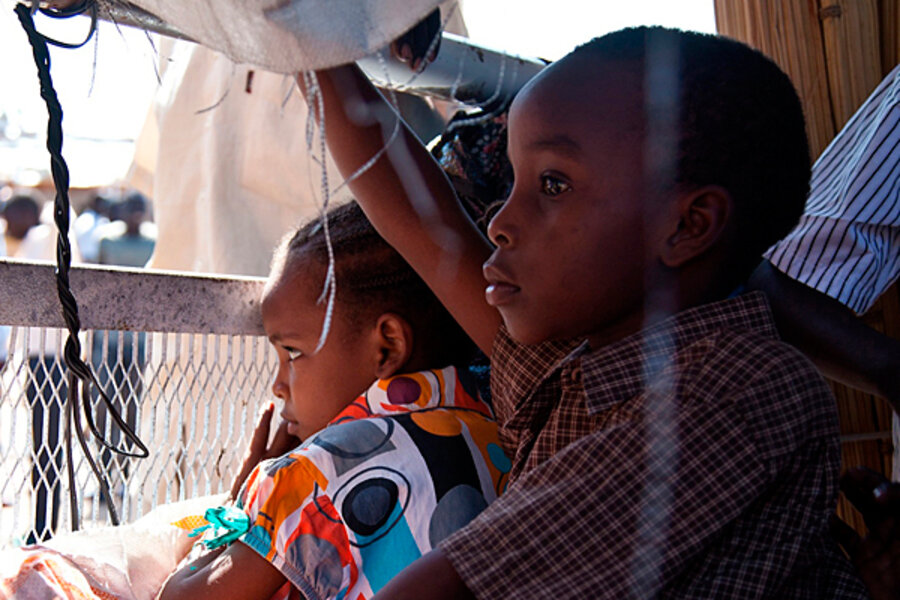South Sudan refugee influx strains Kenyan camps
Loading...
| Nairobi, Kenya
Fighting between the newly formed country of South Sudan and its rival, Sudan, has sent a new wave of refugees into Kenya, where camps are already swamped by refugees from other conflict zones, such as Somalia.
Migrants from South Sudan have been arriving at a rate of 150 to 200 people per day at the Kakuma Refugee Camp in northern Kenya, established in 1992 for Sudanese refugees fleeing the 1983 to 2005 Sudanese civil war, a conflict that killed some 2 million people. Among the best-known residents were the "lost boys and girls" who fled fighting between, and forced conscription by, the Sudan People's Liberation Army (SPLA) and the Government of Sudan.
The latest influx at Kakuma – many of the people actually displaced by intertribal clashes within South Sudan rather than from the Sudan/South Sudan war – has become so great since January that Kenyan government officials and aid agencies are seeking to establish a new camp, near Kakuma complex. At older camps in Kakuma, resources and sanitation services are stretched to their limit.
These should have been good times for South Sudan, as well as the numerous countries who have hosted South Sudanese refugees for decades, such as Kenya. A comprehensive peace agreement, hammered out in 2005 between the SPLA and Khartoum, paved the way for six years of shared power over a unified Sudan, followed by a referendum that would allow southern Sudanese to secede if they chose. But when South Sudan officially seceded in July 2011, it was an ugly breakup, with plenty of recriminations over border violations and stolen oil resources.
The environment is one in which even the rather common local grievances between rival tribes over land resources can become deadly and can spill across borders, increasing strains on refugee camps that have already lived well beyond their designated life span.
Emmanuel Nyabera, a spokesman for the United Nations High Commissioner for Refugees (UNHCR), says that many of the refugees coming to Kakuma are overflow from refugee camps in Ethiopia, which is closer to the disputed region.
“In the next few months, the [Kakuma] camp will be full to capacity," Mr. Nyabera says. "The people are fleeing interethnic fighting mainly, although there are few from border regions [where there are clashes between the government armies]. We are still anticipating more arrivals.”
UNHCR and other agencies are negotiating with the Kenyan government to set up a camp in an area called Kalobeiyei, about 15.5 miles from the Kakuma refugee camp, says Nyabera. The site has the capacity to host about 100,000 refugees.
For a brief period following the peace agreement, Kakuma started to thin out, as Sudanese refugees made their way back home to rebuild their homes, and their country. But with South Sudanese refugees returning by the hundreds, Kakuma will soon be full again.
"What we are seeing are new arrivals, with a few returnees," says George Kinuthia, the Lutheran World Federation Kakuma area coordinator. "This is due to the going civil war in South Sudan, which is causing the people to flee.”
“The numbers are increasing every day, so there is need for another site," says Patrick Muriira, Kenya's top governmental official in the district of Turkana West, which includes Kakuma. "Refugee camps use resources of the host community, like ground water. The resources in Kakuma have become depleted. As it stands now, Kukuma is overstretched.”
With refugees competing with local Kenyans for water resources, Kenya's government needs to find a solution fast, Mr. Muriira adds. "We want to avoid conflict between the host community and the refugees.”
Mr. Kinuthia says that the local Turkana community has agreed to give up part of its grazing land in order to settle new refugees at the new Kakuma site.
Meanwhile, in the northeastern refugee camps of Dadaab – which bears the dubious title of being the world's largest refugee camp – Somali refugees continue to arrive, fleeing both conflict and hunger. Designed originally for 40,000 people in the early 1990s, it now hosts more than half a million, with 1,000 migrants arriving every day.
Kenya is reluctant to open a new extension for refugees at Dadaab, which has drawn criticism from international aid groups; but when it comes to Kakuma and the South Sudanese, the Kenyans seem more willing. Asked about the seeming difference in attitude, Nyabera stuck to the UN's official line: “The government treats all refugees equally.”





